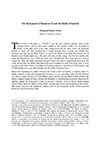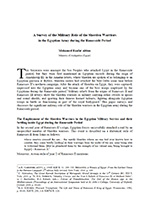Kadesh
« Une iconographie Ă©gyptienne de l’architecture dĂ©fensive »
ENiM 7, 2014, p. 173-219.
 Cet article propose une compilation de toutes les représentations égyptiennes relatives à l’architecture défensive, de la période protohistorique à la Basse Époque. L’inventaire ainsi dressé permet en outre quelques remarques et réflexions sur certains éléments de cette iconographie, sur la manière d’interpréter les illustrations de forts, mais aussi sur les limites que nous imposent les codes artistiques égyptiens.
Cet article propose une compilation de toutes les représentations égyptiennes relatives à l’architecture défensive, de la période protohistorique à la Basse Époque. L’inventaire ainsi dressé permet en outre quelques remarques et réflexions sur certains éléments de cette iconographie, sur la manière d’interpréter les illustrations de forts, mais aussi sur les limites que nous imposent les codes artistiques égyptiens.
 This article proposes a compilation of all the Egyptian representations concerning the defensive architecture, from the Protohistoric period to the Late Period. This inventory allows some remarks and reflections on some elements of this iconography, on interpretation of the illustrations of forts, but also on the limits imposed by the Egyptian artistic codes.
This article proposes a compilation of all the Egyptian representations concerning the defensive architecture, from the Protohistoric period to the Late Period. This inventory allows some remarks and reflections on some elements of this iconography, on interpretation of the illustrations of forts, but also on the limits imposed by the Egyptian artistic codes.
 Consulter cet article (59465) -
Consulter cet article (59465) -  Télécharger cet article au format pdf (29619)
Télécharger cet article au format pdf (29619)
« The Bodyguard of Ramesses II and the Battle of Kadesh »
ENiM 9, 2016, p. 113-123.
 La Bataille de Qadech fut l’affrontement militaire le plus célèbre de l’histoire antique, avant Alexandre, et le premier conflit majeur à être décrit en détail. Ramesses II a clairement considéré la bataille de Qadech comme le sommet de son règne. Dans les descriptions de la bataille, le rôle militaire des gardes du corps de Ramesses II apparaît comme essentiel. Le roi fut sauvé grâce au courage du corps des gardes du corps, composé principalement de Chardanes, après la fuite de ses officiers et soldats aux moments les plus durs de la bataille, qui suivirent l’attaque des Hittites. Cet article analyse le rôle militaire des gardes du corps de Pharaon au cours de cette grande bataille.
La Bataille de Qadech fut l’affrontement militaire le plus célèbre de l’histoire antique, avant Alexandre, et le premier conflit majeur à être décrit en détail. Ramesses II a clairement considéré la bataille de Qadech comme le sommet de son règne. Dans les descriptions de la bataille, le rôle militaire des gardes du corps de Ramesses II apparaît comme essentiel. Le roi fut sauvé grâce au courage du corps des gardes du corps, composé principalement de Chardanes, après la fuite de ses officiers et soldats aux moments les plus durs de la bataille, qui suivirent l’attaque des Hittites. Cet article analyse le rôle militaire des gardes du corps de Pharaon au cours de cette grande bataille.
 The Battle of Kadesh was the most famous military clash in the ancient history and the first major conflict in the ancient world, before Alexander, to be described in detail. Ramesses II clearly regarded the Battle of Kadesh as the peak of his entire reign. The important military role of the bodyguard of Ramesses II was noticeable in the records of Ramesses II on the Battle of Kadesh. Ramesses II rescued in the battlefield, according to the valor of the royal bodyguard, which consisted mostly of the Sherden soldiers, after the escape of his officers and soldiers during the harsh moments of fighting that followed the Hittite attack on the lines of the Egyptian army at the beginning of the battle. This paper discusses the significant military role of the bodyguard of the warrior pharaoh Ramesses II in this great battle
The Battle of Kadesh was the most famous military clash in the ancient history and the first major conflict in the ancient world, before Alexander, to be described in detail. Ramesses II clearly regarded the Battle of Kadesh as the peak of his entire reign. The important military role of the bodyguard of Ramesses II was noticeable in the records of Ramesses II on the Battle of Kadesh. Ramesses II rescued in the battlefield, according to the valor of the royal bodyguard, which consisted mostly of the Sherden soldiers, after the escape of his officers and soldiers during the harsh moments of fighting that followed the Hittite attack on the lines of the Egyptian army at the beginning of the battle. This paper discusses the significant military role of the bodyguard of the warrior pharaoh Ramesses II in this great battle
 Consulter cet article (50764) -
Consulter cet article (50764) -  Télécharger cet article au format pdf (28314)
Télécharger cet article au format pdf (28314)
« A Survey of the Military Role of the Sherden Warriors in the Egyptian Army during the Ramesside Period »
ENiM 10, 2017, p. 7-23.
 Les Chardanes faisaient partie des Peuples de la mer qui attaquèrent l’Égypte pendant la période ramesside. Les pillards chardanes étaient des ennemis de l’Égypte au début du règne de Ramsès II, qui proclama sa victoire sur eux. Après leur défaite, beaucoup d’entre eux furent capturés et intégrés dans l’armée égyptienne, devenant l’une des meilleures troupes d’auxiliaires étrangers. Ils furent employés par les Égyptiens pendant toute la période ramesside. Ils servirent comme unités d’infanterie ou comme gardes du corps du roi. Les célèbres reliefs décrivant la bataille de Qadech et la bataille de Dapour au temps de Ramsès II, la guerre libyenne de Mérenptah, ou les guerres libyennes et du nord de Ramsès III, mentionnent la présence significative des unités chardanes dans l’armée égyptienne. Cet article examine et discute le rôle des guerriers chardanes dans l’armée égyptienne pendant la période ramesside.
Les Chardanes faisaient partie des Peuples de la mer qui attaquèrent l’Égypte pendant la période ramesside. Les pillards chardanes étaient des ennemis de l’Égypte au début du règne de Ramsès II, qui proclama sa victoire sur eux. Après leur défaite, beaucoup d’entre eux furent capturés et intégrés dans l’armée égyptienne, devenant l’une des meilleures troupes d’auxiliaires étrangers. Ils furent employés par les Égyptiens pendant toute la période ramesside. Ils servirent comme unités d’infanterie ou comme gardes du corps du roi. Les célèbres reliefs décrivant la bataille de Qadech et la bataille de Dapour au temps de Ramsès II, la guerre libyenne de Mérenptah, ou les guerres libyennes et du nord de Ramsès III, mentionnent la présence significative des unités chardanes dans l’armée égyptienne. Cet article examine et discute le rôle des guerriers chardanes dans l’armée égyptienne pendant la période ramesside.
 The Sherden were a part of Sea Peoples who attacked Egypt during the Ramesside period. The Sherden raiders were enemies of Egypt at the beginning of the reign of Ramesses II, who proclaimed its victory on them. After their defeat, many of them were captured and integrated into the Egyptian army, becoming one of the best troops of foreign auxiliaries. They were used by Egyptians during all the Ramesside period. They served as units of infantry or as bodyguards of the king. The famous reliefs describing the battle of Qadech and the battle of Dapour in the time of Ramesses II, the Libyan war of Merenptah, and the Libyan and northern wars of Ramesses III, refer to the significant presence of the Sherden units in the Egyptian army. This paper surveys and discusses the military role of Sherden warriors in the Egyptian army during the Ramesside period.
The Sherden were a part of Sea Peoples who attacked Egypt during the Ramesside period. The Sherden raiders were enemies of Egypt at the beginning of the reign of Ramesses II, who proclaimed its victory on them. After their defeat, many of them were captured and integrated into the Egyptian army, becoming one of the best troops of foreign auxiliaries. They were used by Egyptians during all the Ramesside period. They served as units of infantry or as bodyguards of the king. The famous reliefs describing the battle of Qadech and the battle of Dapour in the time of Ramesses II, the Libyan war of Merenptah, and the Libyan and northern wars of Ramesses III, refer to the significant presence of the Sherden units in the Egyptian army. This paper surveys and discusses the military role of Sherden warriors in the Egyptian army during the Ramesside period.
 Consulter cet article (61997) -
Consulter cet article (61997) -  Télécharger cet article au format pdf (27080)
Télécharger cet article au format pdf (27080)
ENiM 18 - 2025
8 article(s) - 8 octobre 2025.
ENiM 1 à 18 (2008-2025) : 227 articles
5 239 283 téléchargements
10 464 329 consulations.
Index des auteurs

Mots clés

Derniers articles : 
CENiM - Mise en ligne des volumes Ă©puisĂ©s : 
 Anne-Sophie von BOMHARD DĂ©cans Ă©gyptiens, CENiM 23, Montpellier, 2020 — (2020)
Anne-Sophie von BOMHARD DĂ©cans Ă©gyptiens, CENiM 23, Montpellier, 2020 — (2020) 
 Jean-Claude Grenier L'Osiris ANTINOOS, CENiM 1, Montpellier, 2008 — (26 dĂ©cembre 2008)
Jean-Claude Grenier L'Osiris ANTINOOS, CENiM 1, Montpellier, 2008 — (26 dĂ©cembre 2008) 
TDENiM - Mise en ligne des volumes Ă©puisĂ©s : 
 Twitter
Twitter 4179936 visites - 12854 visite(s) aujourd’hui - 204 connecté(s)
© ENiM - Une revue d’égyptologie sur internet
Équipe Égypte Nilotique et Méditerranéenne - UMR 5140 - « Archéologie des Sociétés Méditerranéennes » (Cnrs) - Université Paul Valéry - Montpellier III
























 Contact
Contact
 Abonnez-vous !
Abonnez-vous ! Équipe Égypte Nilotique et Méditerranéenne
Équipe Égypte Nilotique et Méditerranéenne UMR 5140 « Archéologie des Sociétés Méditerranéennes » (Cnrs)
UMR 5140 « Archéologie des Sociétés Méditerranéennes » (Cnrs) Université Paul Valéry - Montpellier III
Université Paul Valéry - Montpellier III